Photos
Manage and Transfer iPhone or iPad Photos and Videos with iMazing

Introduction Videos
With the release of iMazing 3, which brought a complete redesign and rewrite of the application, the Photos tool was also significantly enhanced for a more intuitive and powerful experience. For now, the videos below are showing highlights from iMazing 2. They will be updated to reflect the iMazing 3 experience soon.
Windows Screencast
macOS Screencast
Your iPhone or iPad can store thousands of photos and videos — from treasured memories to essential media for creative or professional use. With iMazing, you can easily browse, export, and organize your photo library on Mac or PC, without relying on iCloud or syncing with Photos.
Export your pictures in their original quality, convert HEIC to JPEG for wider compatibility, and preserve Live Photos, RAW files, and video clips with just a few clicks.
Whether you need to back up albums, transfer selected photos to an external drive, or archive your entire library, iMazing offers full control and unmatched flexibility.
Here's how to manage your photos on any Apple mobile device from you computer
- Browsing your Library
- Exporting Photos and Videos
- Importing Photos
- Deleting Photos and Videos
- Backing Up Your Photo Library
- Downloading Photos from iCloud Photo Library
1. Browsing your device
Connect your iPhone, iPad or iPod touch to your computer and click the Photos icon. iMazing will start loading your photo library straight from your mobile device and let you browse it while it's still loading thumbnails in the background. If you've already paired your iOS device with iMazing, you can even access your device's photo library via Wi-Fi, no USB connection required.
1.1 Library View
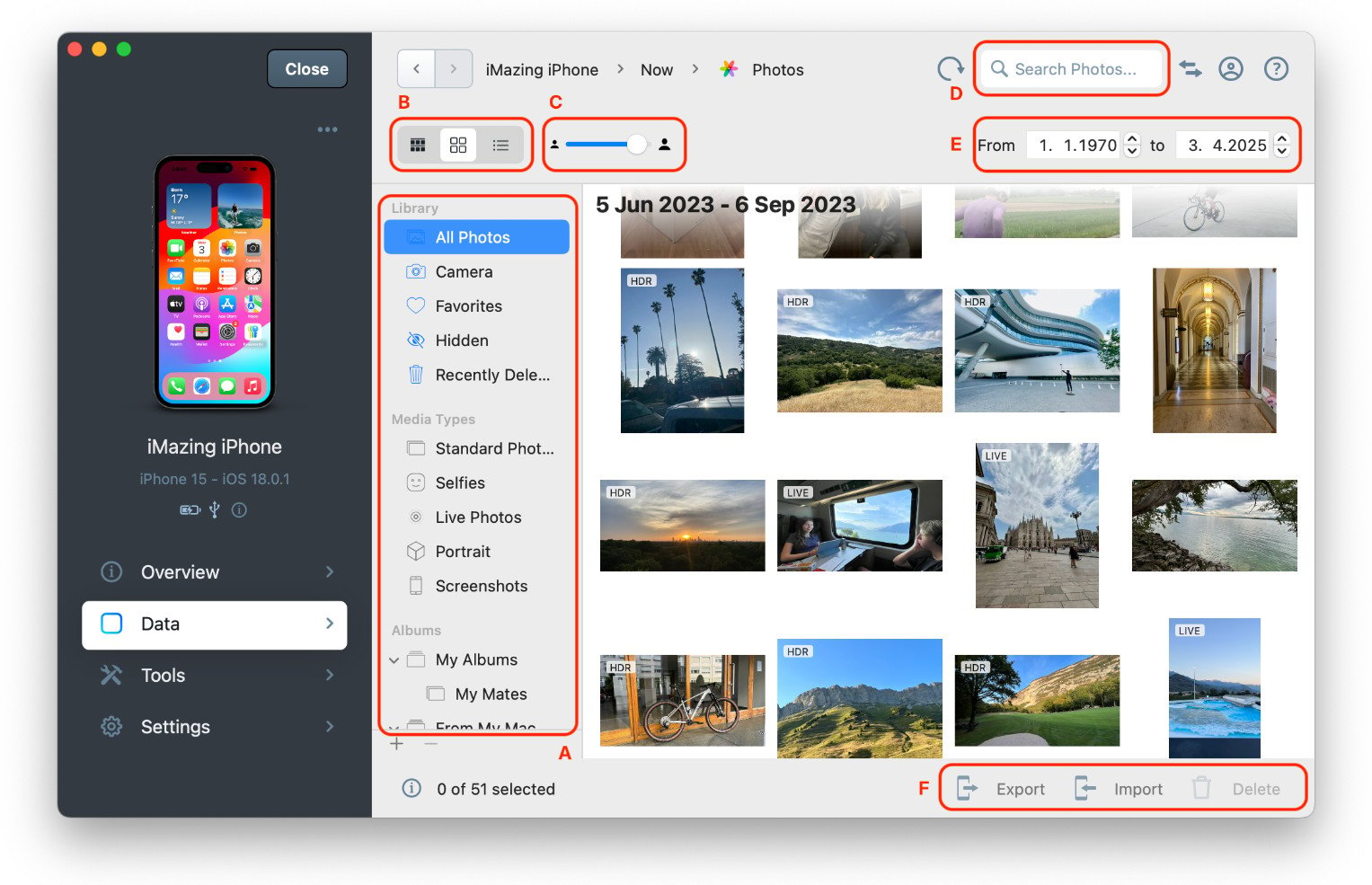
This is the default view iMazing displays once it has loaded your iOS device's photo library. It features the following components:
A. Sidebar
Here, you can select which album or smart album to browse. You can also export entire albums by dragging and dropping them to your desktop, or by opening a context menu on an album with a secondary click. Some albums have unique specificities:
- Camera represents the camera roll.
- Bursts will display all frames of burst photos (other albums will display the key frame only).
- From My Mac albums are albums which you've synced with iTunes or the Finder, or created with iMazing.
B. View Switcher
You can switch between 3 views:
- The Moments view displays photos aggregated by location and date.
- The Grid View displays photos in a grid, with a floating date range badge.
- The Table View displays photos in a table, ideal to see all available fields at a glance and sort by size, size, date or location.
C. Icon Size
- Dynamic Resizing: Use the slider to adjust thumbnail sizes with smooth, real-time updates.
D. Search Bar
iMazing's search bar (top toolbar) is implemented in Photos. The following fields are indexed and will return search results:
- Filename
- Moment Title
- Title
- Description
- Keywords
The last 3 fields are generally empty. On macOS, they can be manually entered in the Photos app.
E. Date Range
You can instruct iMazing to only display photos from a specific date range using this control. By default, this range is set to encompass the date of the first and last asset in your device's photo library.
F. Action Buttons
Export, Import and Delete action buttons are available here. If nothing is selected, only the Import action will be enabled.
⚡ Drag and drop workflow: Most actions can be performed by dragging and dropping items to or from iMazing's window. If you export assets to your Desktop in this way, default export settings will be applied. Use the Export button to gain additional options.
1.2 Selecting Items
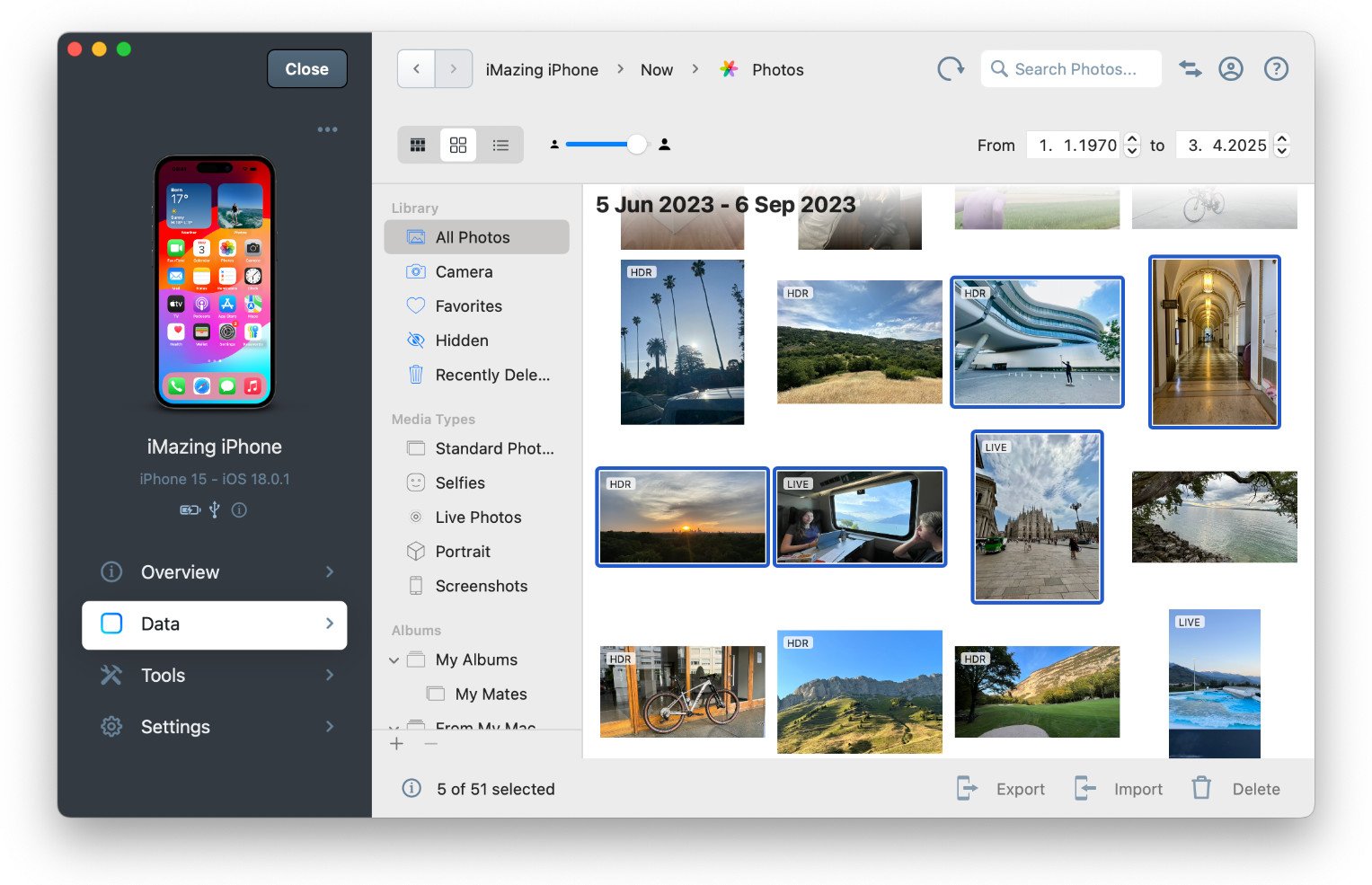
- Single Item: Click a photo thumbnail to select it.
- Range Selection: Click the first item, then hold the Shift key and click the last item in your desired range.
- Multiple Selection: Hold the Command (or Ctrl on Windows) key while clicking to add items.
- Select All: Use the standard
⌘+A(orCtrl+A) shortcut, or choose Select All from the Edit menu.
Actions are applied to selected items only. Selected items can be directly dragged out of the window for quick export.
1.3 Detail View
Double-click an item (or select it and press the spacebar) to open it in the Detail View. iMazing 3 provides an enhanced, immersive preview with updated navigation controls.
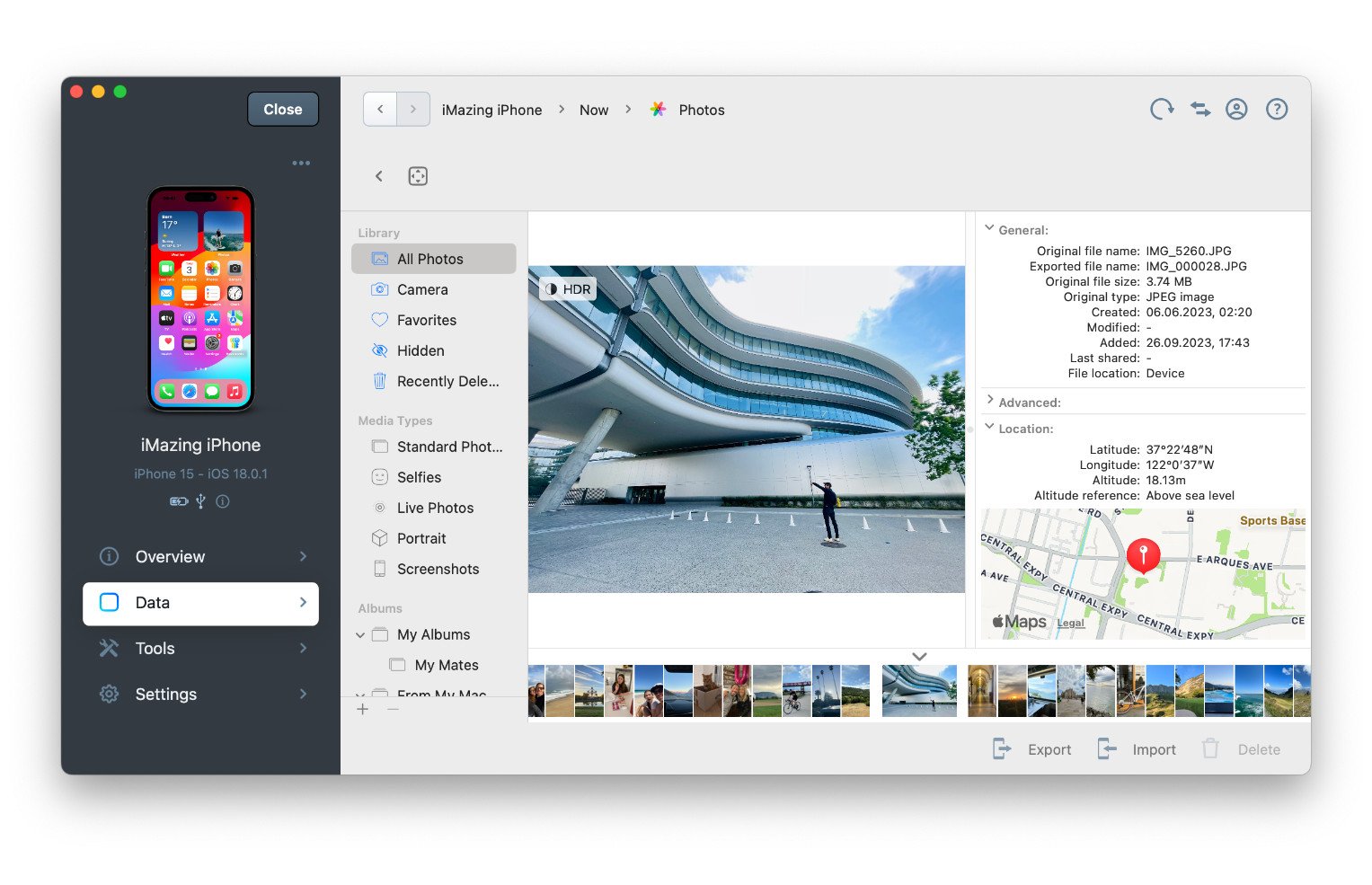
Navigation Features
- Swipe Navigation: Swipe with two fingers on the preview image, or click and drag with your mouse to move between photos.
- On-Screen Arrows: Updated arrow buttons appear on either side of the image when you hover, allowing quick navigation.
- Keyboard Shortcuts: Use the left and right arrow keys to browse through photos.
- Thumbnail Carousel: A redesigned carousel below the preview displays additional thumbnails. Click any thumbnail to jump directly to that photo, or swipe to scroll through.
Full Screen Mode
Double-click the preview image to enter full screen mode. You can double-click again to exit, or press the escape key. Note that you can still navigate in full screen mode, using the same controls described above.
Assets and Metadata View
To the right of the preview image is a scrollable view containing any additional assets and metadata available for the current photo or video.
This view is divided in 4 collapsable sections:
- Assets displays thumbnails of available additional assets for the current item. This section is hidden if there are none.
- General section lists general information about the photo or video.
- Advanced section features metadata about the camera, exposure, depth of field and more
- Location section lists longitude, latitude and elevation, and displays a Google Maps capture of the location which you can double-click to open it in Google Maps. This section is hidden if no location data is available.
Additional assets include:
- All frames of bursts
- Original versions of edited items
- Originals of Portrait Mode photos (no bokeh effect)
- The photo and video components of Live Photos
- Original photo of automatically re-framed pictures (Smart Frame)
Here's a cropped live photo:
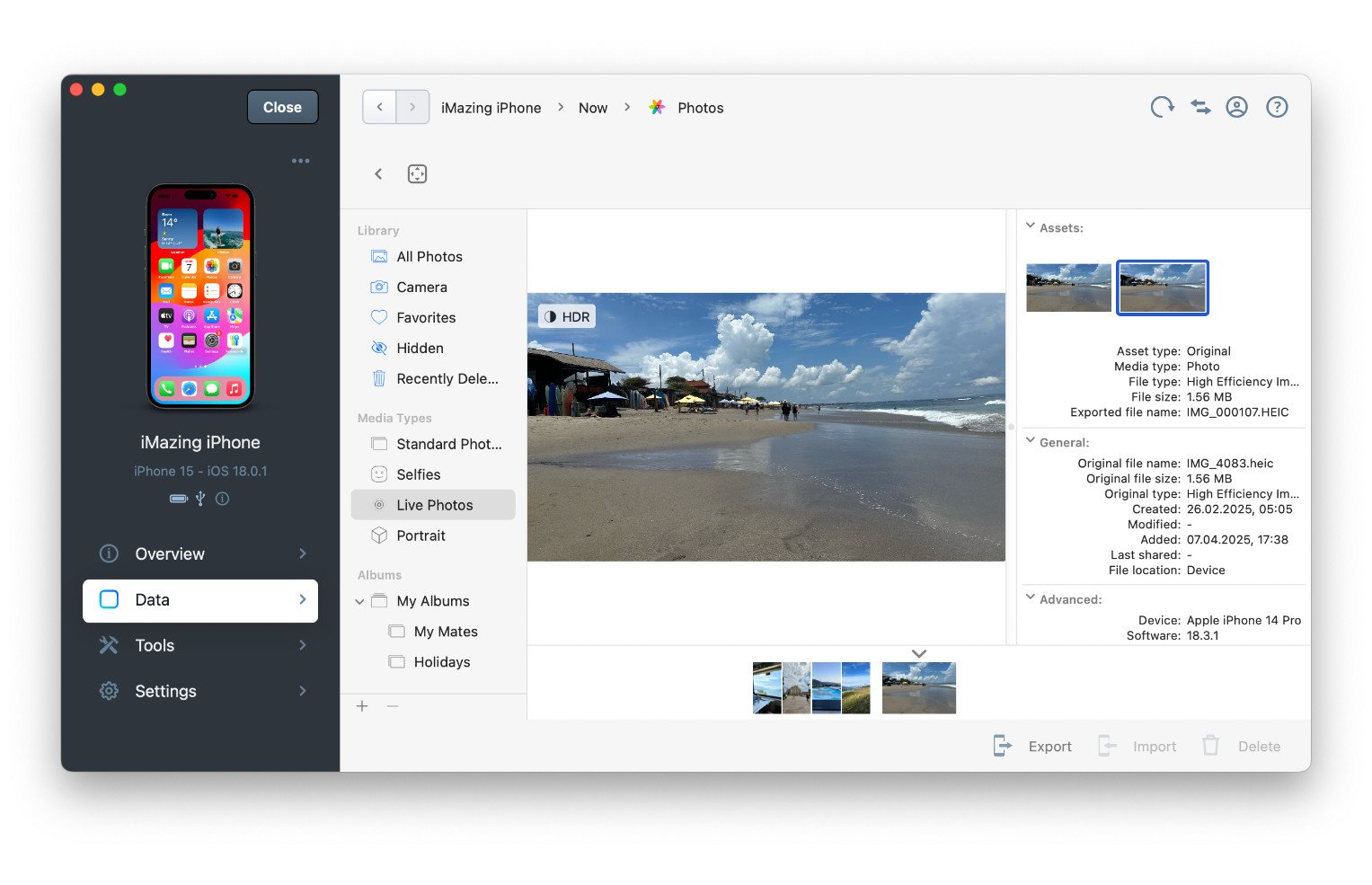 Notice that we've selected the original photo (second thumbnail in the Assets section of the Metadata view here). By default, the edited live photo is displayed, it's the current asset which represents this item in your library.
Notice that we've selected the original photo (second thumbnail in the Assets section of the Metadata view here). By default, the edited live photo is displayed, it's the current asset which represents this item in your library.
You can select and export these assets by dragging and dropping them to your computer. The Export section of this guide below explains how you can bulk export additional assets, too.
2. Exporting Photos and Videos
Exporting in iMazing 3 is optimized for speed and customization. You can export items either via drag-and-drop or using the updated Export dialog.
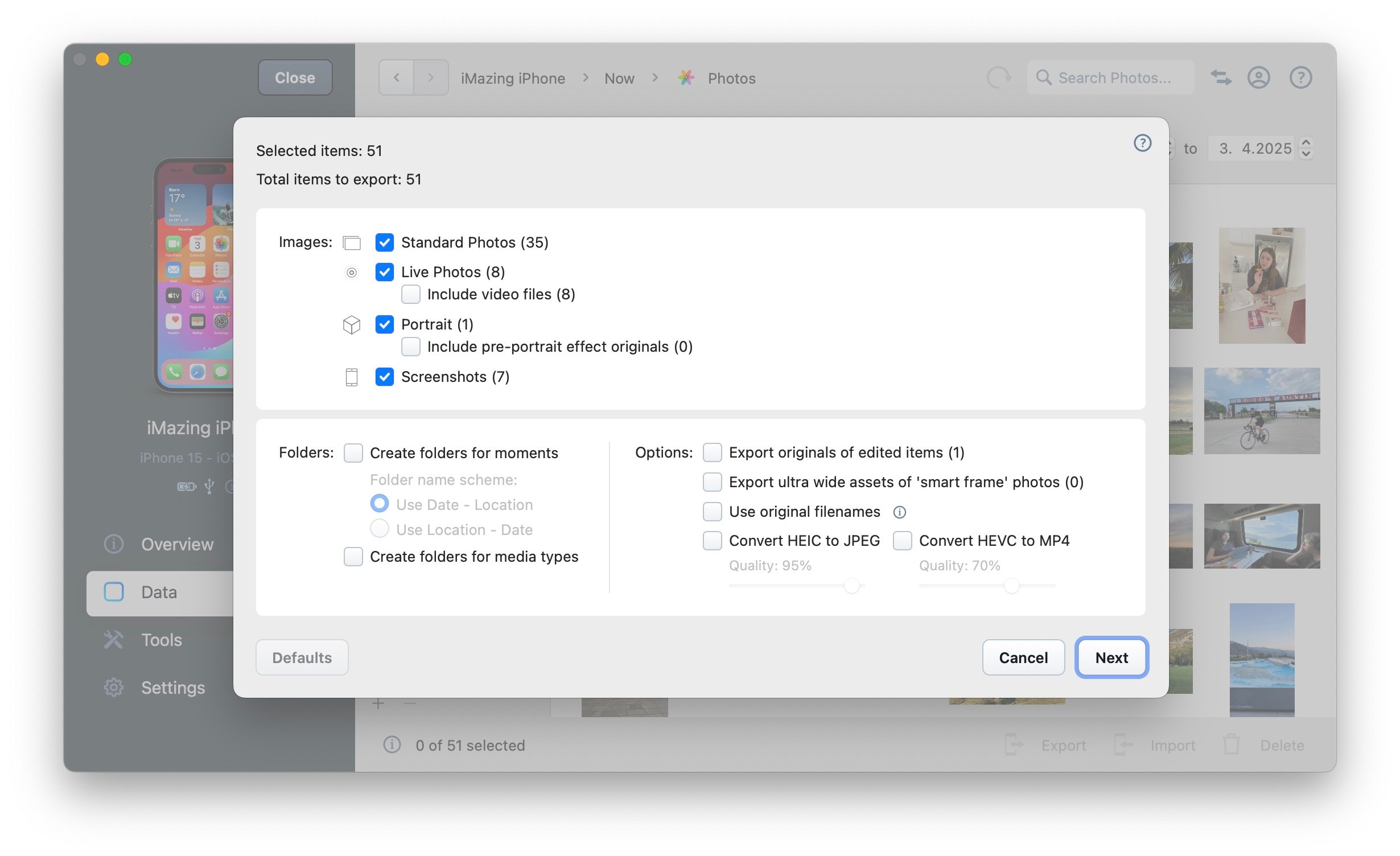
- Drag-and-Drop: Simply drag photos or albums from iMazing to your desktop. Default export settings are applied automatically.
- Enhanced Export Options: Click the Export button to access a detailed options sheet.
Options are grouped in 3 sections:
Media Types and Assets
In the first section, you can choose which types of media to export, photos, videos, screenshots, etc. You also can pick which extra assets are included:
- Video files of Live Photos
- Pre-portrait effect originals of Portrait Mode photos
- All frames of bursts
Using these options, you can easily export only the video files of live photos, for example, or all portrait mode photos without the original assets, as you like!
Folders
The second section is about folder hierarchy:
- Create folders for moments will create one folder per moment
- Create folders for media types will create one folder per media type
If both options are checked, Media Type folders will be nested in Moments folders as illustrated below:
New York - 2020-03-01PhotosLive Photos
San Jose - 2020-02-10PhotosVideosScreenshots
Other Options
- Export originals: If selected, iMazing will also export the original version of edited photos or videos.
- Use original filenames: Filenames used by your device are non-descriptive, so iMazing uses its own naming scheme. Check this box to stick to preserve the original filenames.
- Convert HEIC to JPG: Check this option and adjust the quality slider if you'd like iMazing to automatically convert images in High Efficiency Format (HEIC/HEIF) to JPEG. (JPEG images are larger in file size, but more widely compatible.)
Once you've configured export options, click Next and choose a target location on your computer or external drive. iMazing will begin exporting and report progress in the Operations Window, which will pop open automatically.
3. Importing Photos
To import photos, you can drag and drop image files or folders anywhere in iMazing's Library view. iMazing will prompt you to enter an album name:
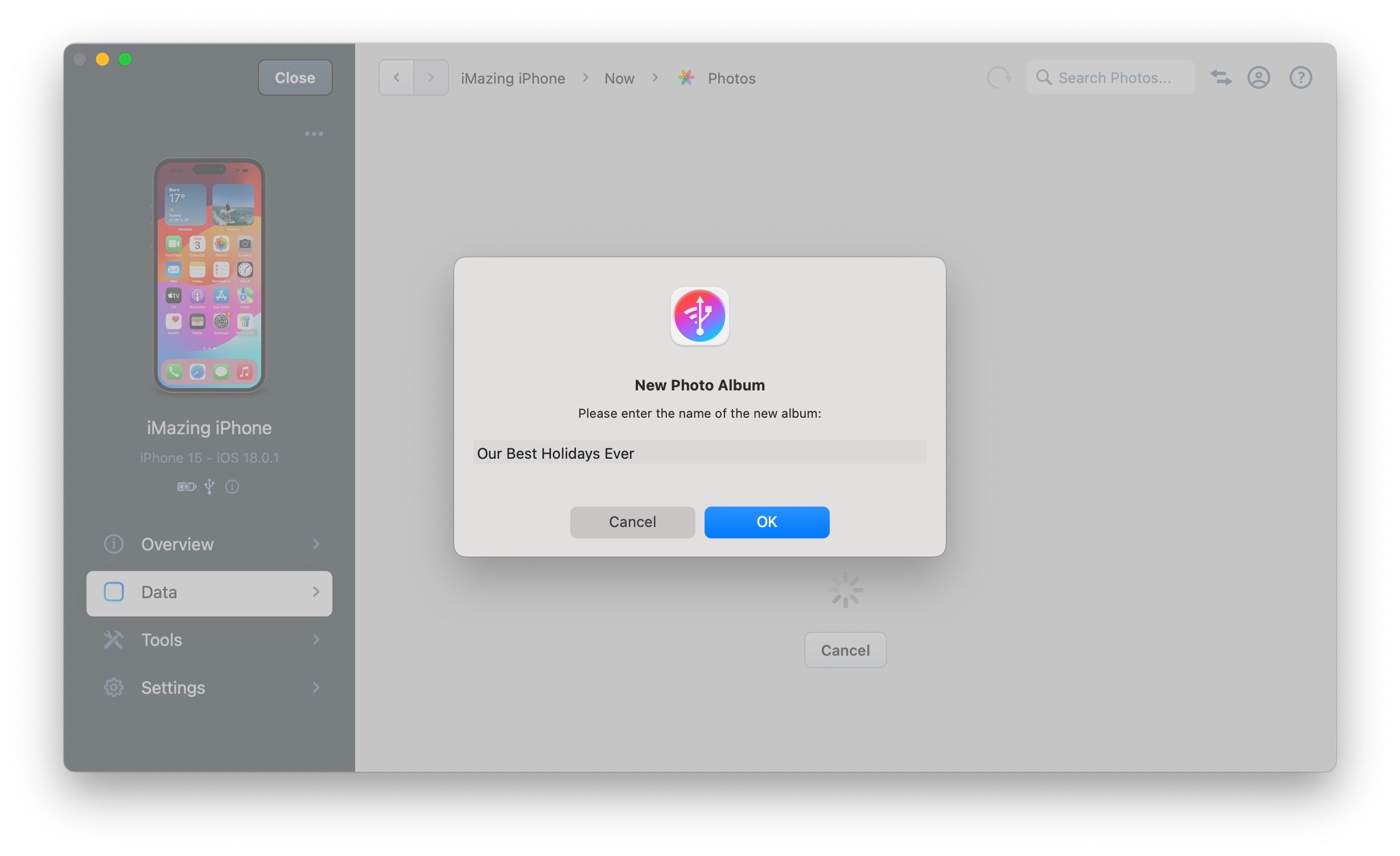
All imported albums are listed under the From My Mac section of the sidebar.
You can also import photos by clicking the Import button in the bottom toolbar and selecting image files or folders. In both cases, iMazing will prompt you to name your album.
Managing Items in Existing Albums
- To add items: Select an existing From My Mac album in the sidebar, and drag and drop new media files.
- To delete items: Select specific images in an album, then click the Delete button. Delete an entire album by either deleting all images it contains, or deleting the album itself.
⚠ Important: Synced albums, whether they are managed by iTunes, the Finder, or iMazing, are always listed under the From My Mac section, which is how the iOS/iPadOS Photos app labels them. They cannot be edited on the mobile device itself, a restriction imposed by Apple that iMazing cannot workaround.
⚠ Also Important: Photos added with iMazing do not become part of a device's Camera Roll, and are therefore excluded from device backups. This behavior is consistent with other computer-synchronized albums.
4. Deleting Photos and Videos
You can only delete photos from the camera roll (if iCloud Photo Library is disabled) or from From My Mac albums.
To delete from the camera roll, select Camera in the sidebar, then the items you wish to delete, then click the Delete button in the bottom toolbar. iMazing will ask you to unlock your iPhone or iPad – this is necessary for deleting only.
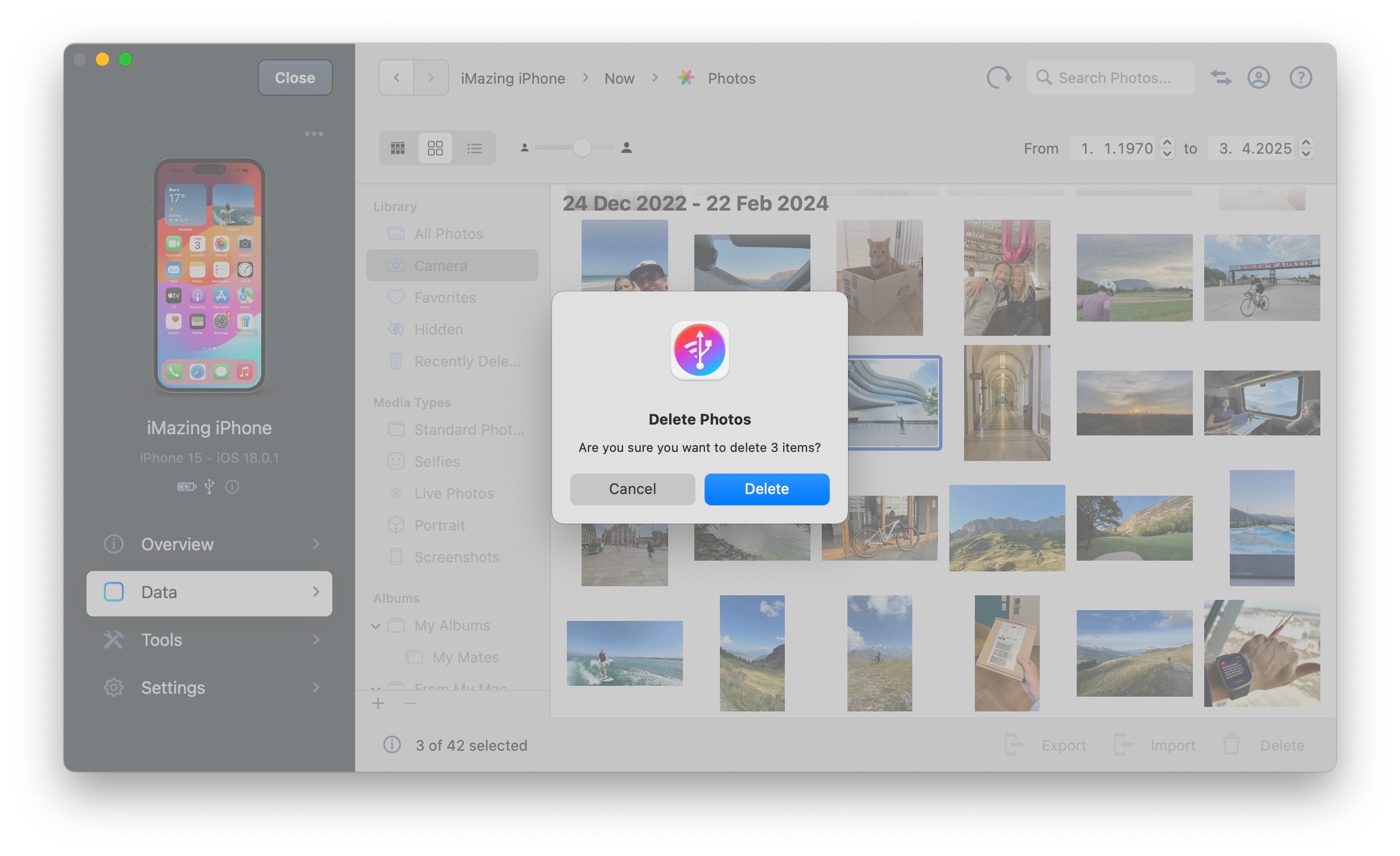
Please note: Photos deleted this way do not go to the Recently Deleted album, so make sure you have a backup of your mobile device before proceeding.
⚡ If you have use iCloud Photo Library, photos can only be deleted directly from the iPhone, with Apple's Photos app, or via iCloud.com.
⚠ macOS Privacy: Since macOS 10.15.3, Apple increased the security protecting access to connected digital cameras. When deleting photos from your iPhone's camera roll, macOS considers the phone as a digital camera and will prompt you to authorize iMazing to access your Photo library and external volumes. iMazing will not access your Mac's photo library, but you still must give this authorization in order for iMazing to be allowed by macOS to delete photos from a connected iPhone or iPad.
5. Backing Up your Photo Library
Your iPhone or iPad's photo library is included when you perform a full backup of your device in iMazing. However, if you use iCloud Photo Library and have enabled the Optimize Storage setting, some photos and videos maybe be stored on iCloud and not on your device. (See the next section for more details about iCloud Photo Library assets.)
Recovering Photos from a Backup
You can browse your photo library from any backup in the exact same way as you browse the photo library of a device. Learn how to browse backups in iMazing.
If you are using iMazing's Backup Archives feature, you can jump in the past to any snapshot of your backup and easily recover accidentally deleted photos, as shown in this screenshot:
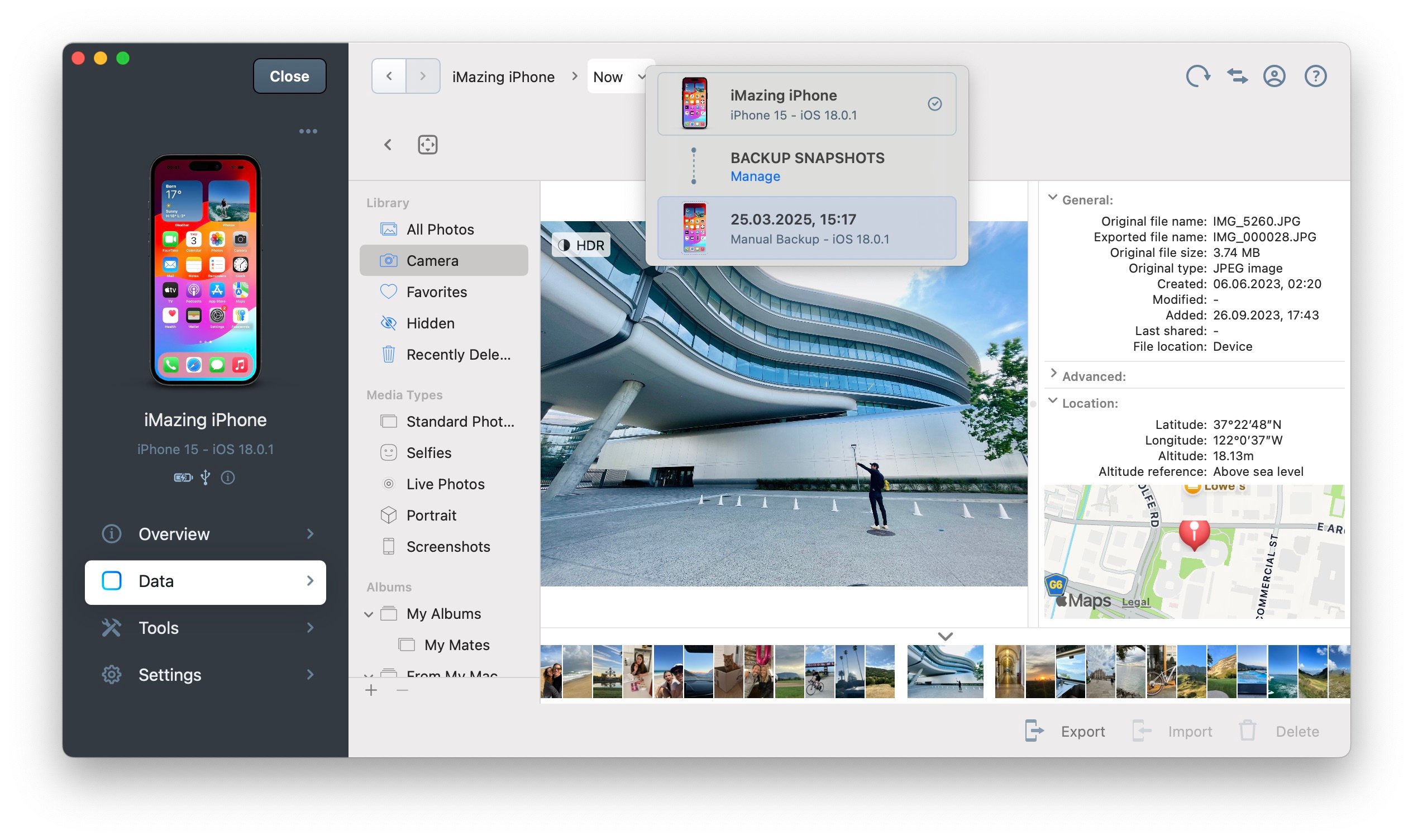
Here, we're browsing the Recently Deleted album of a 90 day old backup snapshot. That photo was automatically deleted from iCloud and the device since, but is easily recovered thanks to iMazing's Time Machine-like backup archives.
6. Downloading Photos from iCloud Photo Library
Since October 2022, with the release of version 2.16, iMazing supports downloading photos and videos that are stored on iCloud.
- In Cloud Identification: Photos stored on iCloud display an In Cloud overlay. Only a lower-resolution thumbnail is shown until the full image is downloaded.- Integrated Download Process: When exporting an iCloud-stored photo, iMazing will prompt you to log in to your iCloud account to download the media.
Your Apple Account credentials remain secure, stored in your macOS keychain or Windows credentials.
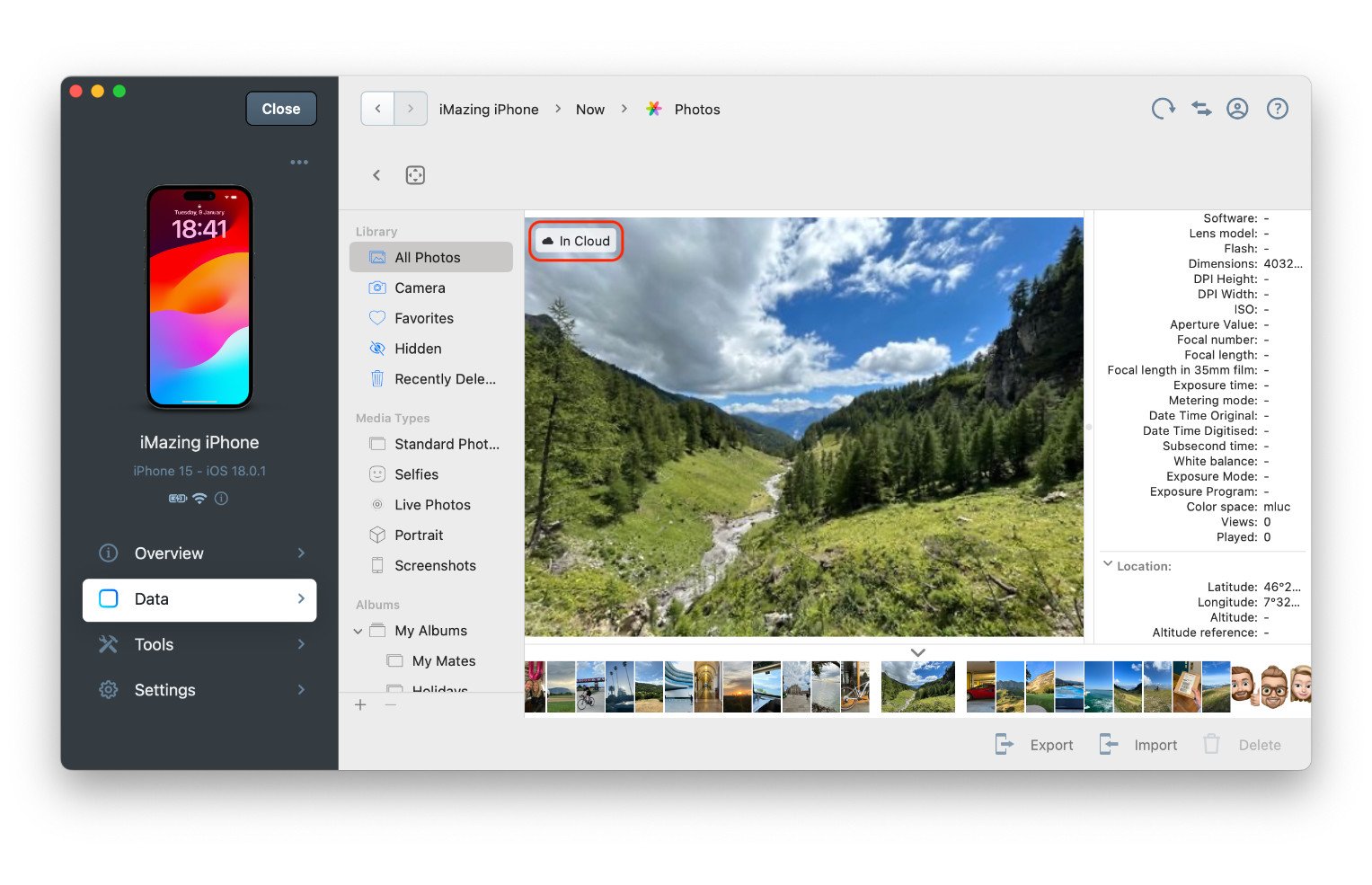
If you attempt to export media stored on iCloud, iMazing will prompt you to log in to iCloud with your Apple ID to download them.

💡 Note: Your Apple Account and password are only used to connect to Apple servers and will remain protected in your macOS keychain or Windows credentials. Learn more about how we value Security & Privacy.



